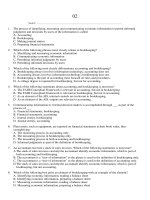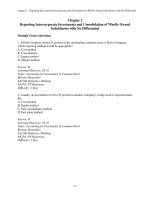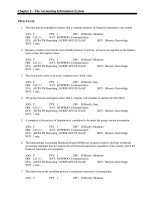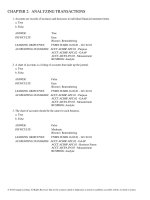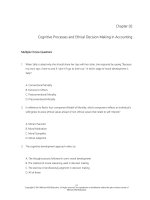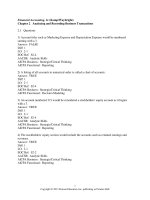Financial accounting 3rd edition spiceland test bank
Bạn đang xem bản rút gọn của tài liệu. Xem và tải ngay bản đầy đủ của tài liệu tại đây (411.75 KB, 64 trang )
Chapter 02 - The Accounting Cycle: During the Period
File: Chapter 002 The Accounting Cycle: During the Period
True/False
[Question]
1. External transactions are transactions the firm conducts with a separate economic entity, such
as selling products to a customer, purchasing supplies from a vendor, paying salaries to an
employee, and borrowing money from a bank.
Answer: True
Learning Objective: 02-01
Difficulty: Easy
AACSB: Reflective Thinking
AICPA: BB Critical Thinking
Blooms: Remember
Topic: External Transactions
[Question]
2. Internal transactions are events that affect the financial position of the company but do not
include an exchange with a separate economic entity. Examples are using supplies on hand and
earning revenues after having received cash in advance from a customer.
Answer: True
Learning Objective: 02-01
Difficulty: Easy
AACSB: Reflective Thinking
AICPA: BB Critical Thinking
Blooms: Remember
Topic: Internal Transactions
[Question]
3. A list of all account names used to record transactions of a company is referred to as a Taccount.
Answer: False
Feedback: This is referred to as a chart of accounts.
Learning Objective: 02-01
Difficulty: Easy
AACSB: Reflective Thinking
AICPA: BB Critical Thinking
Blooms: Remember
Topic: Chart of Accounts
[Question]
4. After recording each transaction, total assets must equal total liabilities plus stockholders’
equity.
Answer: True
2-1
Copyright © 2014 McGraw-Hill Education. All rights reserved. No reproduction or distribution without the prior written consent of McGrawHill Education.
Chapter 02 - The Accounting Cycle: During the Period
Learning Objective: 02-02
Difficulty: Easy
AACSB: Reflective Thinking
AICPA: FN Measurement
Blooms: Remember
Topic: Effect of Transactions on Accounting Equation
[Question]
5. If a transaction causes total assets of the company to increase by $2,000, then liabilities plus
stockholders’ equity also increases by $2,000.
Answer: True
Learning Objective: 02-02
Difficulty: Hard
AACSB: Analytic
AICPA: FN Measurement
Blooms: Apply
Topic: Effect of Transactions on Accounting Equation
[Question]
6. If a transaction causes total assets of the company to increase by $5,000 and total liabilities to
increase by $3,000, then stockholders’ equity increases by $8,000.
Answer: False
Feedback: Assets ($5,000) = Liabilities ($3,000) + Stockholders’ Equity ($2,000).
Learning Objective: 02-02
Difficulty: Hard
AACSB: Analytic
AICPA: FN Measurement
Blooms: Apply
Topic: Effect of Transactions on Accounting Equation
[Question]
7. Borrowing cash from the bank causes assets to increase and liabilities to increase.
Answer: True
Learning Objective: 02-02
Difficulty: Medium
AACSB: Reflective Thinking
AICPA: FN Measurement
Blooms: Understand
Topic: Effect of Transactions on Accounting Equation
[Question]
8. Purchasing equipment using cash causes assets to increase.
Answer: False
Feedback: One asset goes up; another asset goes down. There is no change to total assets.
Learning Objective: 02-02
Difficulty: Medium
2-2
Copyright © 2014 McGraw-Hill Education. All rights reserved. No reproduction or distribution without the prior written consent of McGrawHill Education.
Chapter 02 - The Accounting Cycle: During the Period
AACSB: Reflective Thinking
AICPA: FN Measurement
Blooms: Understand
Topic: Effect of Transactions on Accounting Equation
[Question]
9. Providing services to customers for cash causes stockholders’ equity to increase.
Answer: True
Learning Objective: 02-02
Difficulty: Medium
AACSB: Reflective Thinking
AICPA: FN Measurement
Blooms: Understand
Topic: Effect of Transactions on Accounting Equation
[Question]
10. Incurring employees’ salaries but not paying them causes no change to stockholders’ equity.
Answer: False
Feedback: Salaries expense would reduce stockholders’ equity.
Learning Objective: 02-02
Difficulty: Medium
AACSB: Reflective Thinking
AICPA: FN Measurement
Blooms: Understand
Topic: Effect of Transactions on Accounting Equation
[Question]
11. Paying dividends to its stockholders causes a company’s stockholders’ equity to decrease.
Answer: True
Learning Objective: 02-02
Difficulty: Medium
AACSB: Reflective Thinking
AICPA: FN Measurement
Blooms: Understand
Topic: Effect of Transactions on Accounting Equation
[Question]
12. Selling common stock for cash causes assets to increase and stockholders’ equity to decrease.
Answer: False
Feedback: Stockholders’ equity increases.
Learning Objective: 02-02
Difficulty: Medium
AACSB: Reflective Thinking
AICPA: FN Measurement
Blooms: Understand
Topic: Effect of Transactions on Accounting Equation
2-3
Copyright © 2014 McGraw-Hill Education. All rights reserved. No reproduction or distribution without the prior written consent of McGrawHill Education.
Chapter 02 - The Accounting Cycle: During the Period
[Question]
13. Purchasing office supplies on account causes assets to increase and liabilities to increase.
Answer: True
Learning Objective: 02-02
Difficulty: Medium
AACSB: Reflective Thinking
AICPA: FN Measurement
Blooms: Understand
Topic: Effect of Transactions on Accounting Equation
[Question]
14. Providing services to customers on account causes assets to increase and stockholders’ equity
to increase.
Answer: True
Learning Objective: 02-02
Difficulty: Medium
AACSB: Reflective Thinking
AICPA: FN Measurement
Blooms: Understand
Topic: Effect of Transactions on Accounting Equation
[Question]
15. Receiving cash in advance from a customer for services to be provided in the future causes
assets to increase and stockholders’ equity to increase.
Answer: False
Feedback: Assets increase and liabilities increase.
Learning Objective: 02-02
Difficulty: Medium
AACSB: Reflective Thinking
AICPA: FN Measurement
Blooms: Understand
Topic: Effect of Transactions on Accounting Equation
[Question]
16. Paying for one year of rent in advance does not affect the accounting equation.
Answer: True
Learning Objective: 02-02
Difficulty: Medium
AACSB: Reflective Thinking
AICPA: FN Measurement
Blooms: Understand
Topic: Effect of Transactions on Accounting Equation
[Question]
17. Purchasing supplies on account increases the balance of the Accounts Receivable account.
2-4
Copyright © 2014 McGraw-Hill Education. All rights reserved. No reproduction or distribution without the prior written consent of McGrawHill Education.
Chapter 02 - The Accounting Cycle: During the Period
Answer: False
Feedback: The balance of Accounts Payable increases.
Learning Objective: 02-02
Difficulty: Medium
AACSB: Reflective Thinking
AICPA: FN Measurement
Blooms: Understand
Topic: Effect of Transactions on Accounting Equation
[Question]
18. Amounts owed from customers are recorded in the Accounts Receivable account.
Answer: True
Learning Objective: 02-02
Difficulty: Medium
AACSB: Reflective Thinking
AICPA: FN Measurement
Blooms: Understand
Topic: Effect of Transactions on Accounting Equation
[Question]
19. The two components of stockholders’ equity are Debits and Credits.
Answer: False
Feedback: The two components of stockholders’ equity are Common Stock and Retained
Earnings.
Learning Objective: 02-02
Difficulty: Medium
AACSB: Reflective Thinking
AICPA: FN Measurement
Blooms: Understand
Topic: Expanded Accounting Equation
[Question]
20. Revenues have the effect of increasing retained earnings.
Answer: True
Learning Objective: 02-02
Difficulty: Medium
AACSB: Reflective Thinking
AICPA: FN Measurement
Blooms: Understand
Topic: Expanded Accounting Equation
[Question]
21. Expenses have the effect of decreasing retained earnings.
Answer: True
Learning Objective: 02-02
Difficulty: Medium
2-5
Copyright © 2014 McGraw-Hill Education. All rights reserved. No reproduction or distribution without the prior written consent of McGrawHill Education.
Chapter 02 - The Accounting Cycle: During the Period
AACSB: Reflective Thinking
AICPA: FN Measurement
Blooms: Understand
Topic: Expanded Accounting Equation
[Question]
22. Receiving cash in advance from customers increases the Service Revenue account.
Answer: False
Feedback: Receiving cash in advance from customers increases the Unearned Revenue account.
Learning Objective: 02-02
Difficulty: Medium
AACSB: Reflective Thinking
AICPA: FN Measurement
Blooms: Understand
Topic: Effect of Transactions on Accounting Equation
[Question]
23. Unearned Revenue is a liability account.
Answer: True
Learning Objective: 02-02
Difficulty: Easy
AACSB: Reflective Thinking
AICPA: FN Measurement
Blooms: Remember
Topic: Account Types
[Question]
24. Liability accounts increase with a debit and decrease with a credit.
Answer: False
Feedback: Liability accounts increase with a credit and decrease with a debit.
Learning Objective: 02-03
Difficulty: Medium
AACSB: Reflective Thinking
AICPA: FN Measurement
Blooms: Understand
Topic: Debits and Credits
[Question]
25. Liability accounts increase with a credit and decrease with a debit.
Answer: True
Learning Objective: 02-03
Difficulty: Medium
AACSB: Reflective Thinking
AICPA: FN Measurement
Blooms: Understand
Topic: Debits and Credits
2-6
Copyright © 2014 McGraw-Hill Education. All rights reserved. No reproduction or distribution without the prior written consent of McGrawHill Education.
Chapter 02 - The Accounting Cycle: During the Period
[Question]
26. Common Stock increases with a credit and decreases with a debit.
Answer: True
Learning Objective: 02-03
Difficulty: Medium
AACSB: Reflective Thinking
AICPA: FN Measurement
Blooms: Understand
Topic: Debits and Credits
[Question]
27. Revenue accounts increase with a debit and decrease with a credit.
Answer: False
Feedback: Revenue accounts increase with a credit and decrease with a debit.
Learning Objective: 02-03
Difficulty: Medium
AACSB: Reflective Thinking
AICPA: FN Measurement
Blooms: Understand
Topic: Debits and Credits
[Question]
28. Expense accounts increase with a debit and decrease with a credit.
Answer: True
Learning Objective: 02-03
Difficulty: Medium
AACSB: Reflective Thinking
AICPA: FN Measurement
Blooms: Understand
Topic: Debits and Credits
[Question]
29. The Dividends account increases with a credit and decreases with a debit.
Answer: False
Feedback: The Dividends account increases with a debit and decreases with a credit.
Learning Objective: 02-03
Difficulty: Medium
AACSB: Reflective Thinking
AICPA: FN Measurement
Blooms: Understand
Topic: Debits and Credits
[Question]
30. A debit to an account balance always results in the balance increasing.
Answer: False
2-7
Copyright © 2014 McGraw-Hill Education. All rights reserved. No reproduction or distribution without the prior written consent of McGrawHill Education.
Chapter 02 - The Accounting Cycle: During the Period
Feedback: A debit increases assets, dividends, and expenses, but decreases liabilities,
stockholders’ equity, and revenues.
Learning Objective: 02-03
Difficulty: Medium
AACSB: Reflective Thinking
AICPA: FN Measurement
Blooms: Understand
Topic: Debits and Credits
[Question]
31. A credit to an account balance always results in the balance decreasing.
Answer: False
Feedback: A credit decreases assets, dividends, and expenses, but increases liabilities,
stockholders’ equity, and revenues.
Learning Objective: 02-03
Difficulty: Medium
AACSB: Reflective Thinking
AICPA: FN Measurement
Blooms: Understand
Topic: Debits and Credits
[Question]
32. A journal provides a chronological record of all transactions affecting a firm.
Answer: True
Learning Objective: 02-04
Difficulty: Easy
AACSB: Reflective Thinking
AICPA: BB Critical Thinking
Blooms: Remember
Topic: Recording Transactions
[Question]
33. For each transaction, there must be at least one debit amount and one credit amount.
Answer: True
Learning Objective: 02-04
Difficulty: Medium
AACSB: Reflective Thinking
AICPA: FN Measurement
Blooms: Understand
Topic: Recording Transactions
[Question]
34. For each transaction, the total debit amounts must equal the total credit amounts.
Answer: True
Learning Objective: 02-04
Difficulty: Medium
2-8
Copyright © 2014 McGraw-Hill Education. All rights reserved. No reproduction or distribution without the prior written consent of McGrawHill Education.
Chapter 02 - The Accounting Cycle: During the Period
AACSB: Reflective Thinking
AICPA: FN Measurement
Blooms: Understand
Topic: Recording Transactions
[Question]
35. Selling common stock for cash is recorded with a debit to common stock.
Answer: False
Feedback: Selling common stock for cash is recorded with a credit to common stock.
Learning Objective: 02-04
Difficulty: Medium
AACSB: Reflective Thinking
AICPA: FN Measurement
Blooms: Understand
Topic: Recording Transactions
[Question]
36. Borrowing cash from the bank is recorded with a debit to cash.
Answer: True
Learning Objective: 02-04
Difficulty: Medium
AACSB: Reflective Thinking
AICPA: FN Measurement
Blooms: Understand
Topic: Recording Transactions
[Question]
37. Purchasing office supplies is recorded with a credit to office supplies.
Answer: False
Feedback: Purchasing office supplies is recorded with a debit to office supplies.
Learning Objective: 02-04
Difficulty: Medium
AACSB: Reflective Thinking
AICPA: FN Measurement
Blooms: Understand
Topic: Recording Transactions
[Question]
38. Paying employees’ salaries for the current period is recorded with a debit to Salaries
Expense.
Answer: True
Learning Objective: 02-04
Difficulty: Medium
AACSB: Reflective Thinking
AICPA: FN Measurement
Blooms: Understand
2-9
Copyright © 2014 McGraw-Hill Education. All rights reserved. No reproduction or distribution without the prior written consent of McGrawHill Education.
Chapter 02 - The Accounting Cycle: During the Period
Topic: Recording Transactions
[Question]
39. Providing services to customers is recorded with a debit to Service Revenue.
Answer: False
Feedback: Providing services to customers is recorded with a credit to Service Revenue.
Learning Objective: 02-04
Difficulty: Medium
AACSB: Reflective Thinking
AICPA: FN Measurement
Blooms: Understand
Topic: Recording Transactions
[Question]
40. The general ledger includes all accounts used to record the company’s transactions.
Answer: True
Learning Objective: 02-05
Difficulty: Easy
AACSB: Reflective Thinking
AICPA: BB Critical Thinking
Blooms: Remember
Topic: Posting Transactions
[Question]
41. The process of transferring the debit and credit information from the journal to individual
accounts in the general ledger is called journalizing.
Answer: False
Feedback: The process is called posting.
Learning Objective: 02-05
Difficulty: Easy
AACSB: Reflective Thinking
AICPA: BB Critical Thinking
Blooms: Remember
Topic: Posting Transactions
[Question]
42. After posting transactions to the general ledger accounts, the sum of the accounts with debit
balances should equal the sum of the accounts with credit balances.
Answer: True
Learning Objective: 02-06
Difficulty: Medium
AACSB: Reflective Thinking
AICPA: BB Critical Thinking
Blooms: Understand
Topic: Trial Balance
2-10
Copyright © 2014 McGraw-Hill Education. All rights reserved. No reproduction or distribution without the prior written consent of McGrawHill Education.
Chapter 02 - The Accounting Cycle: During the Period
[Question]
43. A trial balance is a list of all accounts and their balances at a particular date, showing that
assets equal liabilities.
Answer: False
Feedback: The trial balance shows that total debits equal total credits.
Learning Objective: 02-06
Difficulty: Easy
AACSB: Reflective Thinking
AICPA: BB Critical Thinking
Blooms: Remember
Topic: Trial Balance
[Question]
44. If total debits equal total credits in the trial balance, then all balances are correct.
Answer: False
Feedback: A trial balance could contain offsetting errors where the balance of one account is
misstated in one direction but the balance of another account (with the same type of debit or
credit balance) is misstated in the other direction.
Learning Objective: 02-06
Difficulty: Medium
AACSB: Reflective Thinking
AICPA: BB Critical Thinking
Blooms: Understand
Topic: Trial Balance
Multiple Choice
[Question]
45. Which of the following is not part of measuring external transactions?
a. Using source documents to analyze accounts affected.
b. Recording transactions.
c. Making payments on all amounts owed.
d. Analyzing transactions for their effect on the accounting equation.
Answer: c
Learning Objective: 02-01
Difficulty: Easy
AACSB: Reflective Thinking
AICPA: BB Critical Thinking
Blooms: Remember
Topic: Measuring External Transactions
[Question]
46. External events include all of the following except:
a. Paying employees’ salaries.
2-11
Copyright © 2014 McGraw-Hill Education. All rights reserved. No reproduction or distribution without the prior written consent of McGrawHill Education.
Chapter 02 - The Accounting Cycle: During the Period
b. Purchasing equipment.
c. Using office supplies.
d. Collecting an account receivable.
Answer: c
Learning Objective: 02-01
Difficulty: Medium
AACSB: Reflective Thinking
AICPA: BB Critical Thinking
Blooms: Understand
Topic: External Transactions
[Question]
47. The full set of procedures used to accomplish the FN Measurement/communication process
of financial accounting is referred to as the:
a. Trial balance
b. Accounting cycle
c. Chart of accounts
d. General ledger
Answer: b
Learning Objective: 02-01
Difficulty: Easy
AACSB: Reflective Thinking
AICPA: BB Critical Thinking
Blooms: Remember
Topic: Accounting Cycle
[Question]
48. Which step in the process of measuring external transactions involves assessing the equality
of total debits and total credits?
a. Use source documents to determine accounts affected by the transaction.
b. Prepare a trial balance.
c. Analyze the impact of the transaction on the accounting equation.
d. Post the transaction to the T-account in the general ledger.
Answer: b
Learning Objective: 02-01
Difficulty: Medium
AACSB: Reflective Thinking
AICPA: BB Critical Thinking
Blooms: Understand
Topic: Measuring External Transactions
[Question]
49. For each transaction recorded in an accounting system, the basic equation that must be
maintained at all times is:
a. Assets = Liabilities + Stockholders’ Equity.
b. Cash Increases = Cash Decreases.
2-12
Copyright © 2014 McGraw-Hill Education. All rights reserved. No reproduction or distribution without the prior written consent of McGrawHill Education.
Chapter 02 - The Accounting Cycle: During the Period
c. Revenues = Expenses + Dividends.
d. Assets = Liabilities.
Answer: a
Learning Objective: 02-02
Difficulty: Easy
AACSB: Reflective Thinking
AICPA: FN Measurement
Blooms: Remember
Topic: Effect of Transactions on Accounting Equation
[Question]
50. The following amounts are reported in the ledger of Mariah Company:
Assets
Liabilities
Retained Earnings
$80,000
36,000
12,000
What is the balance in the Common Stock account?
a. $44,000.
b. $32,000.
c. $48,000.
d. $42,000.
Answer: b
Learning Objective: 02-02
Difficulty: Hard
AACSB: Analytic
AICPA: FN Measurement
Blooms: Analyze
Topic: Accounting Equation
[Question]
51. When a company incurs employee salaries but does not pay them, how will the basic
accounting equation be affected?
a. Stockholders’ equity decreases.
b. Revenues decrease.
c. Expenses decrease.
d. Liabilities decrease.
Answer: a
Learning Objective: 02-02
Difficulty: Medium
AACSB: Reflective Thinking
AICPA: FN Measurement
Blooms: Understand
Topic: Effect of Transactions on Accounting Equation
[Question]
2-13
Copyright © 2014 McGraw-Hill Education. All rights reserved. No reproduction or distribution without the prior written consent of McGrawHill Education.
Chapter 02 - The Accounting Cycle: During the Period
52. When cash payments are made to stockholders, what is the effect on the company’s
accounts?
a. Cash decreases and dividends increase.
b. Cash increases and dividends decrease.
c. Cash decreases and common stock decreases.
d. Cash increases and common stock increases.
Answer: a
Learning Objective: 02-02
Difficulty: Medium
AACSB: Reflective Thinking
AICPA: FN Measurement
Blooms: Understand
Topic: Effect of Transactions on Accounting Equation
[Question]
53. Which of the following is not an asset account?
a. Supplies.
b. Accounts Payable.
c. Equipment.
d. Accounts Receivable.
Answer: b
Learning Objective: 02-02
Difficulty: Easy
AACSB: Reflective Thinking
AICPA: FN Measurement
Blooms: Remember
Topic: Account Types
[Question]
54. An account receivable can best be defined as:
a. A payment to the owners.
b. A sale of goods and services.
c. A resource owned by the company.
d. An amount owed by the company.
Answer: c
Learning Objective: 02-02
Difficulty: Easy
AACSB: Reflective Thinking
AICPA: BB Critical Thinking
Blooms: Remember
Topic: Account Types
[Question]
55. Receiving assets from customers before services are performed results in:
a. Prepaid Assets.
b. Service Revenue.
2-14
Copyright © 2014 McGraw-Hill Education. All rights reserved. No reproduction or distribution without the prior written consent of McGrawHill Education.
Chapter 02 - The Accounting Cycle: During the Period
c. Unearned Revenues.
d. Accounts Receivable.
Answer: c
Learning Objective: 02-02
Difficulty: Medium
AACSB: Reflective Thinking
AICPA: FN Measurement
Blooms: Understand
Topic: Account Types
[Question]
56. When the company pays stockholders a dividend, what is the effect on the accounting
equation for that company?
a. Decrease stockholders’ equity and increase assets.
b. Increase liabilities and increase assets.
c. Decrease assets and decrease liabilities.
d. Decrease assets and decrease stockholders’ equity.
Answer: d
Learning Objective: 02-02
Difficulty: Medium
AACSB: Reflective Thinking
AICPA: FN Measurement
Blooms: Understand
Topic: Effect of Transactions on Accounting Equation
[Question]
57. Pumpkin Inc. sold $500 in pumpkins to a customer on account on January 1. On January 11
Pumpkin collected the cash from that customer. What is the impact on Pumpkin’s accounting
equation from the collection of cash?
a. No net effect to the accounting equation.
b. Decrease assets and increase liabilities.
c. Increase assets and increase liabilities.
d. Decrease assets and decrease liabilities.
Answer: a
Learning Objective: 02-02
Difficulty: Hard
AACSB: Reflective Thinking
AICPA: FN Measurement
Blooms: Apply
Topic: Effect of Transactions on Accounting Equation
[Question]
58. A company receives a $50,000 cash deposit from a customer on October 15 but will not
provide services until November 20. Which of the following statements is true?
a. The company records service revenue on October 15.
b. The company records cash collection November 20.
2-15
Copyright © 2014 McGraw-Hill Education. All rights reserved. No reproduction or distribution without the prior written consent of McGrawHill Education.
Chapter 02 - The Accounting Cycle: During the Period
c. The company records unearned revenue on October 15.
d. The company records nothing on October 15.
Answer: c
Learning Objective: 02-02
Difficulty: Hard
AACSB: Reflective Thinking
AICPA: FN Measurement
Blooms: Apply
Topic: Recording Transactions
[Question]
59. Which of the following would increase assets and increase liabilities?
a. Provide services to customers on account.
b. Purchase office supplies on account.
c. Pay dividends to stockholders.
d. Receive a utility bill but do not pay it immediately.
Answer: b
Learning Objective: 02-02
Difficulty: Medium
AACSB: Reflective Thinking
AICPA: FN Measurement
Blooms: Understand
Topic: Effect of Transactions on Accounting Equation
[Question]
60. Receiving cash from an account receivable:
a. Increases revenue and decreases an asset.
b. Decreases a liability and increases an asset.
c. Increases an asset and increases revenue.
d. Increases one asset and decreases another asset.
Answer: d
Learning Objective: 02-02
Difficulty: Medium
AACSB: Reflective Thinking
AICPA: FN Measurement
Blooms: Understand
Topic: Effect of Transactions on Accounting Equation
[Question]
61. An expense has what effect on the accounting equation?
a. Decrease liabilities.
b. Decrease stockholders’ equity.
c. Increase assets.
d. No effect.
Answer: b
Learning Objective: 02-02
2-16
Copyright © 2014 McGraw-Hill Education. All rights reserved. No reproduction or distribution without the prior written consent of McGrawHill Education.
Chapter 02 - The Accounting Cycle: During the Period
Difficulty: Medium
AACSB: Reflective Thinking
AICPA: FN Measurement
Blooms: Understand
Topic: Effect of Transactions on Accounting Equation
[Question]
62. Revenues have what effect on the accounting equation?
a. Increase liabilities.
b. Decrease assets.
c. Increase stockholders’ equity.
d. No effect.
Answer: c
Learning Objective: 02-02
Difficulty: Medium
AACSB: Reflective Thinking
AICPA: FN Measurement
Blooms: Understand
Topic: Effect of Transactions on Accounting Equation
[Question]
63. Investments by stockholders have what effect on the accounting equation?
a. Assets increase and liabilities increase.
b. Expenses increase and liabilities increase.
c. Assets increase and revenues increase.
d. Assets increase and stockholders' equity increases.
Answer: d
Learning Objective: 02-02
Difficulty: Medium
AACSB: Reflective Thinking
AICPA: FN Measurement
Blooms: Understand
Topic: Effect of Transactions on Accounting Equation
[Question]
64. Which of the following is not possible when recording a transaction?
a. Liabilities increase and assets decrease.
b. Stockholders’ equity increases and assets increase.
c. One asset increases and another asset decreases.
d. Stockholders’ equity decreases and assets decrease.
Answer: a
Learning Objective: 2
Difficulty: Hard
AACSB: Reflective Thinking
AICPA: FN Measurement
Blooms: Analyze
2-17
Copyright © 2014 McGraw-Hill Education. All rights reserved. No reproduction or distribution without the prior written consent of McGrawHill Education.
Chapter 02 - The Accounting Cycle: During the Period
Topic: Effect of Transactions on Accounting Equation
[Question]
65. Amounts owed to suppliers for supplies purchased on account are defined as:
a. Cash.
b. Accounts Receivable.
c. Accounts Payable.
d. Supplies Expense.
Answer: c
Learning Objective: 02-02
Difficulty: Easy
AACSB: Reflective Thinking
AICPA: BB Critical Thinking
Blooms: Remember
Topic: Account Types
[Question]
66. Purchasing office supplies on account will:
a. Not change assets.
b. Increase assets and decrease liabilities.
c. Increase assets and increase liabilities.
d. Increase assets and increase stockholders’ equity.
Answer: c
Learning Objective: 02-02
Difficulty: Medium
AACSB: Reflective Thinking
AICPA: FN Measurement
Blooms: Understand
Topic: Effect of Transactions on Accounting Equation
[Question]
67. Providing services and receiving cash will:
a. Increase assets and increase stockholders’ equity.
b. Increase assets and increase liabilities.
c. Decrease assets and increase liabilities.
d. Decrease liabilities and increase stockholders’ equity.
Answer: a
Learning Objective: 02-02
Difficulty: Medium
AACSB: Reflective Thinking
AICPA: FN Measurement
Blooms: Understand
Topic: Effect of Transactions on Accounting Equation
[Question]
2-18
Copyright © 2014 McGraw-Hill Education. All rights reserved. No reproduction or distribution without the prior written consent of McGrawHill Education.
Chapter 02 - The Accounting Cycle: During the Period
68. When a company provides services on account, the accounting equation would be affected as
follows:
a. Assets increase.
b. Revenues increase.
c. Assets increase and liabilities decrease.
d. Assets increase and stockholders’ equity increases.
Answer: d
Learning Objective: 02-02
Difficulty: Medium
AACSB: Reflective Thinking
AICPA: FN Measurement
Blooms: Understand
Topic: Effect of Transactions on Accounting Equation
[Question]
69. If a company provides services on account, which of the following is true?
a. Expenses increase.
b. Liabilities increase.
c. Stockholders’ equity increases.
d. Assets decrease.
Answer: c
Learning Objective: 02-02
Difficulty: Medium
AACSB: Reflective Thinking
AICPA: FN Measurement
Blooms: Understand
Topic: Effect of Transactions on Accounting Equation
[Question]
70. When a payment is made on an account payable:
a. Assets and stockholders’ equity decrease.
b. Assets and liabilities decrease.
c. Liabilities and revenues decrease.
d. Assets and expenses decrease.
Answer: b
Learning Objective: 02-02
Difficulty: Medium
AACSB: Reflective Thinking
AICPA: FN Measurement
Blooms: Understand
Topic: Effect of Transactions on Accounting Equation
[Question]
71. Purchasing office equipment on account has what impact on the accounting equation?
a. Stockholders’ equity decreases and assets increase.
b. Liabilities increase and assets increase.
2-19
Copyright © 2014 McGraw-Hill Education. All rights reserved. No reproduction or distribution without the prior written consent of McGrawHill Education.
Chapter 02 - The Accounting Cycle: During the Period
c. Assets decrease and liabilities decrease.
d. Assets increase and stockholders’ equity increases.
Answer: b
Learning Objective: 02-02
Difficulty: Medium
AACSB: Reflective Thinking
AICPA: FN Measurement
Blooms: Understand
Topic: Effect of Transactions on Accounting Equation
[Question]
72. Purchasing supplies for cash has what effect on the accounting equation?
a. Increase assets.
b. Decrease stockholders’ equity.
c. Decrease liabilities.
d. No effect.
Answer: d
Learning Objective: 02-02
Difficulty: Medium
AACSB: Reflective Thinking
AICPA: FN Measurement
Blooms: Understand
Topic: Effect of Transactions on Accounting Equation
[Question]
73. The Unearned Revenue account is shown in which statement?
a. Income statement.
b. Statement of cash flows.
c. Balance sheet.
d. Statement of stockholders’ equity.
Answer: c
Learning Objective: 02-02
Difficulty: Medium
AACSB: Reflective Thinking
AICPA: FN Reporting
Blooms: Understand
Topic: Account Types
[Question]
74. On January 1, Brad Inc. sold $30,000 in products to a customer on account. Then on January
10, Brad collected the cash on that account. What is the impact on Brad’s accounting equation
from the collection of cash on January 10?
a. No net effect to the accounting equation.
b. Assets increase and liabilities decrease.
c. Assets decrease and liabilities decrease.
d. Assets increase and stockholders’ equity increases.
2-20
Copyright © 2014 McGraw-Hill Education. All rights reserved. No reproduction or distribution without the prior written consent of McGrawHill Education.
Chapter 02 - The Accounting Cycle: During the Period
Answer: a
Learning Objective: 02-02
Difficulty: Hard
AACSB: Reflective Thinking
AICPA: FN Measurement
Blooms: Apply
Topic: Effect of Transactions on Accounting Equation
[Question]
75. On September 30, MFP Co. paid employee salaries of $7,000, including $1,000 it owed to its
employees last month. What are the effects of this transaction on the accounting equation?
a. Expenses increased, liabilities increased, and assets increased.
b. Assets decreased, liabilities decreased, and expenses increased.
c. Assets decreased, expenses decreased, and liabilities increased.
d. Expenses decreased, liabilities decreased, and assets decreased.
e. Assets increased, expenses increased, and liabilities decreased.
Answer: b
Learning Objective: 02-02
Difficulty: Hard
AACSB: Reflective Thinking
AICPA: FN Measurement
Blooms: Apply
Topic: Effect of Transactions on Accounting Equation
[Question]
76. Following are transactions of Gotebo Tanners, Inc., a new company, during the month of
January:
1. Issued 10,000 shares of common stock for $15,000 cash.
2. Purchased land for $12,000, signing a note payable for the full amount.
3. Purchased office equipment for $1,200 cash.
4. Received cash of $14,000 for services provided to customers during the month.
5. Purchased $300 of office supplies on account.
6. Paid employees $10,000 for their first month’s salaries.
What was the total amount of Gotebo’s liabilities following these six transactions?
a. $12,300.
b. $27,300.
c. $22,600.
d. $15,500.
Answer: a
Feedback: Liabilities = ($12,000 + $300) = $12,300.
Learning Objective: 02-02
Difficulty: Hard
AACSB: Analytic
AICPA: FN Reporting
Blooms: Analyze
Topic: Effect of Transactions on Accounting Equation
2-21
Copyright © 2014 McGraw-Hill Education. All rights reserved. No reproduction or distribution without the prior written consent of McGrawHill Education.
Chapter 02 - The Accounting Cycle: During the Period
[Question]
77. Consider the following transactions:
Issued common stock for cash.
Purchased equipment by signing a note payable.
Paid rent for the current month.
Collected cash from customers on account.
How many of these four transactions increased the given company’s total assets?
a. One.
b. Two.
c. Three.
d. Four.
Answer: b
Feedback: (1) Issued common stock for cash and (2) purchased equipment by signing a note
payable.
Learning Objective: 02-02
Difficulty: Medium
AACSB: Reflective Thinking
AICPA: FN Measurement
Blooms: Understand
Topic: Effect of Transactions on Accounting Equation
[Question]
78. Assume that Sallisaw Sideboards, Inc. had a retained earnings balance of $10,000 on April 1,
and that the company had the following transactions during April.
Issued common stock for cash, $5,000.
Provided services to customers on account, $2,000.
Provided services to customers in exchange for cash, $900.
Purchased equipment and paid cash, $4,300.
Paid April rent, $800.
Paid employee salaries for April, $700.
What was Sallisaw’s retained earnings balance at the end of April?
a. $11,400.
b. $12,100.
c. $16,400.
d. Some other amount.
Answer: a
Feedback: Beginning retained earnings $10,000 + Net income $1,400 – Dividends $0 = Ending
retained earnings $11,400.
Net Income = Revenue ($2,000 + $900) – Expenses ($800 + $700) = $1,400.
Learning Objective: 02-02
Difficulty: Hard
AACSB: Analytic
AICPA: FN Measurement
Blooms: Analyze
Topic: Effect of Transactions on Accounting Equation
2-22
Copyright © 2014 McGraw-Hill Education. All rights reserved. No reproduction or distribution without the prior written consent of McGrawHill Education.
Chapter 02 - The Accounting Cycle: During the Period
[Question]
79. Consider the following transactions:
Issued common stock for cash.
Purchased equipment by signing a note payable.
Provided services to customers on account.
Collected cash from customers on account.
How many of these four transactions increased the given company’s total liabilities?
a. One.
b. Two.
c. Three.
d. Four.
Answer: a
Feedback: Purchased equipment by signing a note payable.
Learning Objective: 02-02
Difficulty: Medium
AACSB: Reflective Thinking
AICPA: FN Measurement
Blooms: Understand
Topic: Effect of Transactions on Accounting Equation
[Question]
80. Following are transactions of Gotebo Tanners, Inc., a new company, during the month of
January:
1. Issued 10,000 shares of common stock for $15,000 cash.
2. Purchased land for $12,000, signing a note payable for the full amount.
3. Purchased office equipment for $1,200 cash.
4. Received cash of $14,000 for services provided to customers during the month.
5. Purchased $300 of office supplies on account.
6. Paid employees $10,000 for their first month’s salaries.
How many of these transactions decreased Gotebo’s total assets?
a. One.
b. Two.
c. Three.
d. Four.
Answer: a
Feedback: Transaction #6.
Learning Objective: 02-02
Difficulty: Hard
AACSB: Reflective Thinking
AICPA: FN Reporting
Blooms: Apply
Topic: Effect of Transactions on Accounting Equation
[Question]
2-23
Copyright © 2014 McGraw-Hill Education. All rights reserved. No reproduction or distribution without the prior written consent of McGrawHill Education.
Chapter 02 - The Accounting Cycle: During the Period
81. Following are transactions of Gotebo Tanners, Inc., a new company, during the month of
January:
1. Issued 10,000 shares of common stock for $15,000 cash.
2. Purchased land for $12,000, signing a note payable for the full amount.
3. Purchased office equipment for $1,200 cash.
4. Received cash of $14,000 for services provided to customers during the month.
5. Purchased $300 of office supplies on account.
6. Paid employees $10,000 for their first month’s salaries.
How many of these transactions increased Gotebo’s liabilities?
a. Four.
b. Three.
c. Two.
d. One.
Answer: c
Feedback: Transactions #2 and #5.
Learning Objective: 02-02
Difficulty: Hard
AACSB: Reflective Thinking
AICPA: FN Reporting
Blooms: Apply
Topic: Effect of Transactions on Accounting Equation
[Question]
82. Which of the following transactions causes a decrease in stockholders’ equity?
a. Pay dividends to stockholders.
b. Obtain cash by borrowing from a local bank.
c. Provide services to customers on account.
d. Purchase office equipment for cash.
Answer: a
Learning Objective: 02-02
Difficulty: Medium
AACSB: Reflective Thinking
AICPA: FN Measurement
Blooms: Understand
Topic: Effect of Transactions on Accounting Equation
[Question]
83. How many of the following events would require an expense to be recorded?
Ordering office supplies
Hiring a receptionist
Paying employee salaries for the current month
Receiving but not paying a current utility bill
Paying for insurance in advance
a. One.
b. Two.
2-24
Copyright © 2014 McGraw-Hill Education. All rights reserved. No reproduction or distribution without the prior written consent of McGrawHill Education.
Chapter 02 - The Accounting Cycle: During the Period
c. Three.
d. Four.
Answer: b
Feedback: (1) Paying employee salaries for the current month and (2) Receiving but not paying a
current utility bill.
Learning Objective: 02-02
Difficulty: Medium
AACSB: Reflective Thinking
AICPA: FN Measurement
Blooms: Understand
Topic: Effect of Transactions on Accounting Equation
[Question]
84. Which of the following is NOT possible for a business transaction?
a. Increase assets and decrease revenue.
b. Decrease assets and increase expense.
c. Increase liabilities and increase expense.
d. Decrease liabilities and increase revenue.
Answer: a
Learning Objective: 02-02
Difficulty: Hard
AACSB: Reflective Thinking
AICPA: FN Measurement
Blooms: Apply
Topic: Effect of Transactions on Accounting Equation
[Question]
85. Which of the following transactions would cause a decrease in both assets and stockholders’
equity?
a. Paying insurance premium for the next two years.
b. Purchasing office equipment on account.
c. Paying advertising for the current month.
d. Providing installation services to customers.
Answer: c
Learning Objective: 02-02
Difficulty: Hard
AACSB: Reflective Thinking
AICPA: FN Measurement
Blooms: Apply
Topic: Effect of Transactions on Accounting Equation
[Question]
86. When a company issues common stock for cash, what is the effect on the accounting
equation for the company?
a. Assets increase and liabilities increase.
b. Assets increase and stockholders’ equity increases.
2-25
Copyright © 2014 McGraw-Hill Education. All rights reserved. No reproduction or distribution without the prior written consent of McGrawHill Education.
